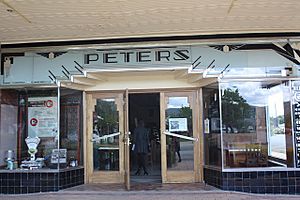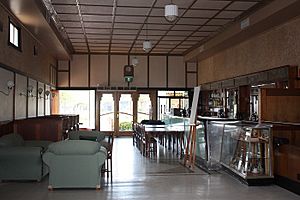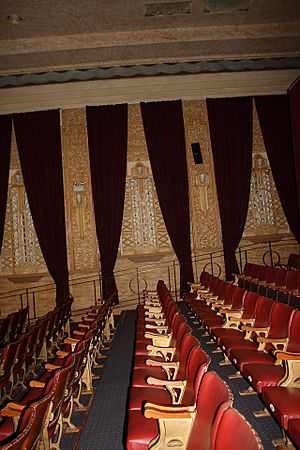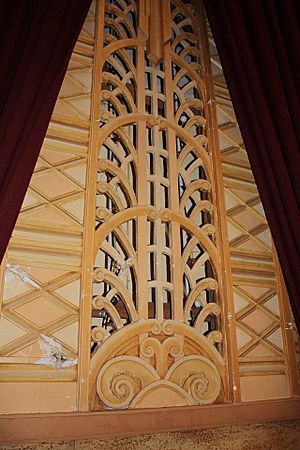Roxy Theatre and Peters Greek Cafe Complex facts for kids
Quick facts for kids Roxy Theatre and Peters Greek Cafe Complex |
|
|---|---|
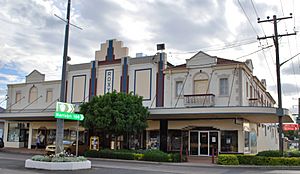 |
|
| Location | 74 Maitland Street, Bingara, Gwydir Shire, New South Wales, Australia |
| Built | 1936–1936 |
| Architect | Mark Woodforde |
| Official name: Roxy Theatre and Peters Greek Cafe Complex | |
| Type | state heritage (complex / group) |
| Designated | 25 August 2017 |
| Reference no. | 1990 |
| Type | Cinema |
| Category | Recreation and Entertainment |
| Lua error in Module:Location_map at line 420: attempt to index field 'wikibase' (a nil value). | |
The Roxy Theatre and Peters Greek Cafe Complex is a special old theatre and cafe in Bingara, Australia. It's listed as a heritage site, which means it's very important to history. The building was designed by Mark Woodforde and built in 1936. George Psaltis, a Greek businessman, helped supervise the building work. This amazing place was added to the New South Wales State Heritage Register on August 25, 2017.
Contents
A Look Back in Time
Early Days in Bingara
The land where Bingara is today was once home to the Kamilaroi and Weraerai Aboriginal people. They hunted and lived off the land. In 1827, a European explorer named Allan Cunningham passed through the area.
By the 1830s, European settlers, called squatters, started to claim land. This led to conflicts between the Aboriginal people and the new settlers. One very sad event was the Myall Creek massacre in 1838. A group of armed men killed many Aboriginal men, women, and children. For the first time, some of the killers were tried and punished by the government.
Gold Rush and Town Growth
In 1851, gold was found near Bingara. This brought many people hoping to find their fortune. Soon, the Bingara goldfield was officially declared in 1853.
To support the gold miners, the town of Bingara was planned out. The first hotel opened in 1853, and a general store followed. By 1862, Bingara had a Post Office and a school.
The town really grew after copper and diamonds were discovered in the 1870s. Bingara became Australia's biggest diamond producer in the 1880s. More buildings like a courthouse and churches were built. In 1889, Bingara became a municipality, and its name changed slightly to Bingara. By 1911, over 1600 people lived there.
Even during the tough times of the 1930s, Bingara continued to grow. Many new homes, shops, and businesses were built.
Many new shops were being built in Bingara. The Imperial Hotel was completely updated. A new movie theatre opened, and another was being built. (Wilson, 2006.)
This growth was partly due to Greek businessmen arriving in town. Plans to build the Copeton Dam nearby also helped.
Greeks and the Rise of Cinema
Many Greek people came to Australia in the early 1900s. They were looking for a better life away from difficult times in Greece. Some of the first Greeks arrived as early as the 1820s. By the late 1800s, Greek communities were growing across Australia.
Greeks from the island of Kythera were very active in business. They often ran oyster saloons and refreshment rooms, which later became known as cafes. When movies became popular, these Greek cafe owners quickly saw a new opportunity. They started to invest in and run local cinemas.
Many Greek business people helped set up and manage cinemas across New South Wales. Some, like Sir Nicholas Laurantus, owned several theatres in different towns. Other families, like the Hatsatouris family, also ran chains of cinemas.
By 1962, there were 351 enclosed cinemas in rural NSW towns. Greek business people had operated 116 of these theatres in 57 towns between 1915 and 1960. They even built 34 new theatres themselves. This shows how much Greek migrants helped shape the social and cultural life of NSW.
Where Greek immigrants had picture theatres they controlled their towns principal entertainment at a time when the overall population attended between 20-30 times a year. (R Thorne. 2003. Nomination to list Athenium, Junee Cinema on the State Heritage Register)
They brought national and international events to the rural areas in the form of feature films, newsreels and documentaries. (K. Cork 1998)
The 1930s to the mid-1960s were the best years for cinemas. Business people made going to the movies a special, glamorous event. They built beautiful "picture palaces" with modern designs. These grand buildings made going to the theatre feel like a big occasion.
The Roxy's Story in Bingara
The Roxy Theatre was built with this idea of glamour in mind. Three Greek businessmen from Kythera were key to its story: Emanuel Aroney, Peter Feros, and George Psaltis. They formed a partnership called Peters and Co. They already owned a cafe in Bingara and another in Barraba.
In 1934, they bought a large piece of land in Bingara. They hired an architect, W. V. E. Woodforde, to design a new entertainment complex. The plans included a modern theatre, a luxurious cafe, three shops, and even a guest house nearby.
Construction began in early 1935, with George Psaltis overseeing the work. The theatre was designed to be very long and wide. Part of the floor could even be cleared to create a special dance floor.
Building the Roxy had some challenges. The walls of the theatre were made taller to allow for a possible upper seating area later. This changed some of the decorations.
The Roxy also faced tough competition from Victor Reginald Peacocke. He was the Mayor of Bingara and already ran a cinema in town. Peacocke tried to stop the Roxy from being built. He even built his own new cinema, 'The Regent', which opened nine months before the Roxy.
When the Roxy Cinema finally opened on Saturday, March 28, 1936, it was a huge event. The local newspaper said, "probably no event in the history of Bingara has caused more interest or excitement." About 700 people packed the theatre, and many more couldn't get in. They watched 'Roberta' starring Fred Astaire and Ginger Rogers.
The competition continued, and the Roxy partners faced mounting debt. Just months after the grand opening, in August 1936, they had to give up ownership of the Roxy. The Greek partners went their separate ways. The Roxy Theatre continued to operate as a cinema under new owners until 1958, when it closed. For the next 40 years, it was mostly empty.
Many cinemas in rural towns closed down from the 1960s onwards. This was mainly because television became very popular. By 2003, only 31 of the 351 cinemas in rural NSW were still recognizable as cinemas. Many were turned into other businesses. The Roxy in Bingara is one of the best examples of an Art Deco cinema that still looks original.
The Roxy Cafe kept running under different Greek owners until the mid-1960s. It was later used as a Chinese restaurant for 20 years. In 2008, the Gwydir Shire Council bought it.
In the early 1990s, local community members realized how important the Roxy was. They worked to convince the council to buy and restore the theatre. The Bingara Council bought the building in 1999. With funding from the state and federal governments, they carefully restored it to its original beauty.
In 2006, after the Roxy reopened, a book called 'Katsehamos and the Great Idea' was published. It told the hidden history of the Roxy Theatre and Cafe. This sparked a lot of interest, especially among the Greek community. Donations and grants helped restore the Roxy Cafe and create a Roxy Greek Museum. The museum opened in April 2014 and has won awards.
Today, the Roxy complex is a busy place. It has the local tourist information office and the Greek museum. The theatre is used for live shows, movie clubs, weddings, and other events. The area above the cafe is now a conference center. A new kitchen was added in 2012 for hospitality courses, allowing catering for events.
Other Greek Cafes
Greek cafes have a rich history in Australia. Almost every town in rural NSW and Queensland once had a Greek cafe. While many have closed, some, like The Paragon in Katoomba and the Niagara in Gundagai, have been open for over 100 years. The Roxy is special because it also had a guesthouse for its customers, which is very rare today.
The Greek cafes changed how Australians ate and socialized. Before them, you could only get meals at certain times in pubs. Greek cafes offered food at all hours, making them popular gathering spots.
What the Roxy Looks Like
The Roxy Theatre is a stunning example of Art Deco architecture. It still has its original decorations, including fancy plasterwork, paint, and colored lights from 1936.
The building faces Maitland Street. It has three shops and a cafe, with the theatre entrance in the middle. The whole complex has a rectangular shape with steps, columns (pilasters), and simple panels. The columns have cool, low-relief patterns.
The shops have large chrome-framed windows and recessed entrances. A stepped design is above each window and entrance. This stepped design is also on the theatre entrance's roofline (parapet). The original colors are white, blue, and maroon. The theatre entrance has two wooden-framed glass doors on either side of the ticket office.
The cafe is on the corner of Maitland and Cunningham streets. Its entrance has three wooden-framed glass folding doors. The sign "Peter's Cafe" above the door is framed with the same stepped chrome design. The front of the complex on Maitland Street is covered with black tiles. The Cunningham Street side of the cafe has arched windows and a Spanish-tiled roof, showing some Interwar Spanish Mission architecture style.
To enter the theatre, you walk through a long, narrow hallway. The floor is made of terrazzo, and the ceiling has a large stepped design with a decorative grille. A few steps lead up to the auditorium doors. The back part of the auditorium has fixed seating on steps. The front part is flat, with movable seats, and has a special cypress pine floor for dancing.
The auditorium's decoration also uses the stepped design. The ceiling steps down to meet the walls. There's a wavy Art Deco pattern and perforated panels between the columns. The wall panels have fan-like and rectangular shapes. Light fittings on the columns look like angular vases. Many of these panels and the ceiling grille helped with air circulation and cooling in summer.
The auditorium has beautiful original paintwork and decorative plaster. These details made going to the theatre a luxurious experience. The stage was originally low but has been removed.
The backstage area has been extended for modern performances. A new kitchen wing was added behind the cafe. This allows the theatre to be used for different events, like education and functions.
Next to the theatre entrance is the original refreshment bar. One of the original shops is now a museum celebrating Greeks in NSW. Another shop was once a doctor's office. The third shop is used as an extension of the entrance. Peter's Cafe is now entered from the theatre by a ramp. The cafe floor has a geometric terrazzo pattern. The cafe's wooden dining booths and wall paneling are original.
The area above the cafe used to be living quarters for the owners. It's now a conference venue. Its original layout is still there, with a large living room, a small kitchen, an office, and bedrooms. A lift has been added for accessibility. The stairway has a metal railing with a unique Art Deco design, found throughout the complex.
The building was in good condition in 2016. The roof and dance floor needed some repairs due to water damage, but these could be fixed. The overall building is in excellent shape. The major restoration work in the early 2000s was done carefully to keep the building's original look and feel.
Changes Over Time
- 2003: The theatre was restored.
- 2007: The backstage area was extended.
- 2012: A new industrial kitchen wing was added.
Why the Roxy is Special
The Roxy Theatre and Peters Greek Cafe Complex is very important to New South Wales. It's a rare example of an Art Deco cinema from the 1930s that still looks original and operates as a theatre today. It shows how important "cinema going" was before television became popular. It also shows how American pop culture, like Hollywood movies, first came to country NSW. The Roxy's design and name were even inspired by the famous Roxy Theatre in New York.
The Roxy Theatre and Cafe Complex is also important because it tells the story of Greek migration to country NSW. Many Greeks came to Australia in the early 1900s and opened cafes and cinemas. The Roxy is a reminder of their journey and how they helped shape Australian culture.
The Roxy is a beautiful example of Art Deco style. Its outside has steps, columns, and decorative patterns. Inside, the detailed ceilings and walls make going to the cinema feel luxurious. The whole complex, including the shops, theatre, and cafe, is still mostly in its original layout. Only the backstage extension and kitchen were added, and they were done carefully.
The Roxy Theatre and Cafe Complex is very special to the Greek Australian Kytherian community. It has become a place where Greeks who grew up with these cafes and cinemas can visit and remember their history.
It's also important to the local community in Bingara. It holds memories for those who grew up going to the cinema there. Today, it continues to be a central place for social and cultural events, like movies, school performances, weddings, and reunions.
The Roxy Theatre and Cafe complex helps us understand the history of cinema and Greek immigration in NSW. Its original design and the museum inside show us what life was like in the 20th century.
It's rare to find a theatre like the Roxy that was built for movies and is still used for that purpose today. Many old cinemas have been changed into shops or apartments. In 1951, there were 351 cinemas in country NSW. By 2003, only 31 were still recognizable as cinemas. Out of these, only about seven Art Deco cinemas in rural NSW still have their original look and are used as theatres. The Roxy is one of the best examples.
The Roxy Theatre and Cafe complex is a great example of an Art Deco cinema in NSW. It's one of the few that are still intact and continue to be a social and cultural hub for the community.


